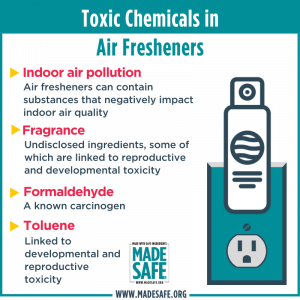Common deodorizing and cleaning techniques can result in dangerous levels of indoor air pollution
Why are Air Fresheners and Common Cleaning Techniques Potentially Harmful?
While surface cleaning is important, deodorizing and cleaning with harsh chemicals can negatively affect indoor air quality and your health if not managed correctly.[1] Many common and sometimes unlisted ingredients used in air fresheners and surface cleaning products have been linked to serious health issues such as:
- Various cancers caused by carcinogens such as Formaldehyde, Styrene and parabens
- Harm to lung functionality and the respiratory system
- Damage to the nervous system
- Headaches, dizziness, fatigue and nausea
- Create irritation to eyes, skin and throat
- Hormonal abnormalities and reproductive issues caused by Phthalates
Other Issues with Air Fresheners and Common Cleaning Products
Air fresheners and cleaning products also contain a wide variety of volatile organic compounds (VOCs).[2] VOCs can be linked to a multitude of health issues including: damage to the respiratory system, eye and throat irritation, headaches, nausea and more. If indoor VOC concentrations are high enough, exposure can even lead to asthma, cancers, neurological damage, and other debilitating health effects.
Recent health studies have shown long-term exposure to air fresheners and fragrances can effect neurological and cognitive functions due to the chemicals present in the ingredients. The study showed that roughly 3.2% of the population has experienced neurological problems and 2.7% contracted negative cognitive issues due to exposures.[3]Some neurological disorders linked to long-term exposure to air fresheners include brain damage, Alzheimer’s disease, autoimmune disorders, and multiple sclerosis.[4]
In addition to more serious health effects, air fresheners and fragrances can simply be an annoyance to some people which lowers occupant comfort. Studies have shown that a majority of people actually prefer indoor environments to be fragrance-free. When asked if they would prefer airplane cabins be supplied with fragrant air, 59.2% of respondents preferred the air be unscented. When asked the same question about hotel rooms, 55.5% of respondents preferred hotel rooms also be unscented.

The Lack of Transparency on Product Ingredient Labels
Disclosing every ingredient is not mandatory for companies that manufacture air fresheners and cleaning products, therefore, most do not. A study found that fewer than 10% of the VOCs within air fresheners, including products that deem themselves as green alternatives, were disclosed on product labels and material safety data sheets.[1] All of the air fresheners tested in this study had chemicals and VOCs categorized as toxic or hazardous under US federal laws. However, less than 1% of these harmful chemicals were disclosed on any product labels.
Are ‘Natural’ or ‘Green’ Products Safer?
Any company can easily include the words “natural” on their product labels to make them appear to be a safer option. However, there are no federal standards that regulate the use of this deceiving marketing. Many products that consider themselves as green alternatives are actually just as harmful as conventional cleaning and deodorizing products. In fact, many ‘natural’ air fresheners and cleaning product brands receive the same failing rating from the Environmental Working Group (EWG) as conventional products.[2]
How to Obtain Fresh, Indoor Air and Clean Surfaces Without the use of Harsh Ingredients?
There are effective ways to mitigate odors, freshen the air and clean surfaces without adding contaminates into the air. Below are some best practices:
- Avoid masking odors with air fresheners or fragrances
- Increase ventilation naturally or mechanically
- Use air cleaners with HEPA filters
- Ensure the HVAC unit is operational and well maintained
- Frequently clean, dust and vacuum with vacuums equipped with HEPA filters
- Find the source of odors or contamination and mitigate
- For cleaning, avoid added fragrances and consider steam and / or soap
- For disinfection, review the EPA registration number and avoid products that have QUATS as an active ingredient
- For safer surface disinfection use products approved by the EPA to fight viruses and use alcohol / ethanol / isopropanol, hydrogen peroxide, lactic acid, citric acid or thymol as active ingredients
- When cleaning or disinfecting surfaces always use proper PPE and allow for ample ventilation
- Conduct periodic, proactive air quality tests
Testing for Chemicals in the Air
Do you currently use air fresheners or harsh chemical cleaning products in your home or business? Have you used them in the past? Indoor Science can conduct tests to determine if the indoor air contains harsh chemicals due to the use of these products. We can also recommend corrective actions for material exchanges that ensure efficacy and safe indoor air. Please contact our offices at 312-920-9393 to discuss potential testing options tailored to your specific situation.
 877-872-4339
877-872-4339  Contact Us
Contact Us 






